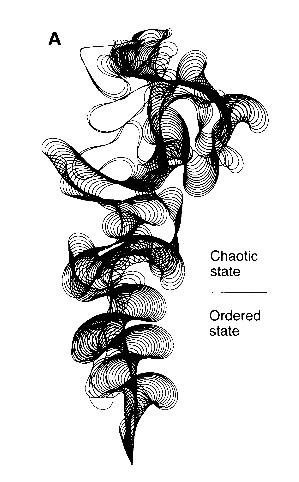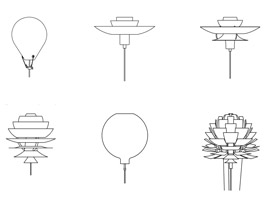 Thermal Curtain | Meandering River (based upon an article written by Hans-Henrik Stølum, Department of Earth Sciences, University of Cambridge, Cambridge CB2 3EQ, UK, in 1996.
Thermal Curtain | Meandering River (based upon an article written by Hans-Henrik Stølum, Department of Earth Sciences, University of Cambridge, Cambridge CB2 3EQ, UK, in 1996.Status: Focusing in on the form and material options for Concept #2, the Thermal Curtain. The concept is to create a 3-dimensional meandering river sculpture, which has the properties of being flat-collapsible, drape-able, and also infinitely expandable. The meandering river sculpture form will be based upon the writing of Hans-Henrik Stølum as well as advances in procedural mathematics which enable scientists to predict river morphology (ie, the sinuosity of a river's meanders, bends, and reaches).
Concept update: The river sculpture is to be fabricated in real-time in the exhibition space, over the duration of the show, by two robots. Ideally, the river should reach great length (ie, over 60 meters) and cascade out of the space's window(s), thus creating a 'waterfall' effect. This waterfall will serve as a thermal curtain to the facade of the building space. Inside of the exhibition hall, the river is designed to meander flexibly. Ideally, the river should flow up at least one of the exhibition hall walls, creating a similar waterfall/ curtain effect on the interior of the building. The river body itself should reach no greater than 1.3 meters in height.
Proposed Robotic Processes: Cutting material from two sides, stacking, gluing, and feeding material forwards.
Potential Materials: Corrugated Cardboard (sheets or rolls) and/ or Recyclable Corrugated Plastic (sheets or rolls)
Examples:
Composite Paneling: image example, application example, Tricel Honeycomb (vendor)
Corrugated Plastic Rolls: corrugatedplastics.net, mdiplastics.com
Clear: corrugatedplastics.net
Translucent Green: Stroh_House
Sheets: Coroplast, Corbiplastics.com
Corrugated_Plastic_Containers.html
Corrugated Cardboard
Corrugated Plastic Rolls: corrugatedplastics.net, mdiplastics.com
Clear: corrugatedplastics.net
Translucent Green: Stroh_House
Sheets: Coroplast, Corbiplastics.com
Corrugated_Plastic_Containers.html
Corrugated Cardboard
Meandering River article. "Simulations of freely meandering rivers and empirical data show that the meandering process self-organizes the river morphology, or planform, into a critical state characterized by fractal geometry. The meandering process oscillates in space and time between a state in which the river planform is ordered and one in which it is chaotic. Clusters of river cutoffs tend to cause a transition between these two states and to force the system into stationary fluctuations around the critical state." Hans-Henrik Stølum, 1996







No comments:
Post a Comment